|
|
Post by kemp on May 13, 2018 4:03:11 GMT -5
These Asian hunter-gatherers may have been the first people to domesticate horses
By Michael Price. A documentary reconstruction shows Botai riders, who may have galloped across Kazakhstan about 3500 B.C.E. (NIOBE THOMPSON) A documentary reconstruction shows Botai riders, who may have galloped across Kazakhstan about 3500 B.C.E. (NIOBE THOMPSON)
The horse revolutionized prehistoric living, allowing people to travel farther and faster than ever before, and to wage war in yet-unheard-of ways. But who first domesticated horses is a hotly debated question. One leading hypothesis suggests Bronze Age pastoralists called the Yamnaya were the first to saddle up, using their fleet transport to sweep out from the Eurasian steppe and spread their culture—and their genes—far and wide. But a new study of ancient DNA suggests that wasn’t the case in Asia, and that another culture, the Botai, domesticated the horse first.
“This is a really exciting paper,” says Priya Moorjani, a geneticist at the University of California, Berkeley, who notes that the field of ancient DNA is moving so quickly that every study reveals something new. Yet other researchers caution that the debate isn’t anywhere near settled.
The first signs of horse domestication—pottery containing traces of mares’ milk and horse teeth with telltale wear from a riding bit—come from the Botai hunter-gatherers who lived in what is now Kazakhstan from about 3700 B.C.E. to 3100 B.C.E. Yet some researchers thought the isolated Botai were unlikely to have invented horse husbandry because they kept to their hunting and gathering ways long after their neighbors had adopted farming and herding.
A documentary reconstruction shows Botai riders, who may have galloped across Kazakhstan about 3500 B.C.E. NIOBE THOMPSON
These Asian hunter-gatherers may have been the first people to domesticate horses
By Michael PriceMay. 9, 2018 , 1:00 PM
The horse revolutionized prehistoric living, allowing people to travel farther and faster than ever before, and to wage war in yet-unheard-of ways. But who first domesticated horses is a hotly debated question. One leading hypothesis suggests Bronze Age pastoralists called the Yamnaya were the first to saddle up, using their fleet transport to sweep out from the Eurasian steppe and spread their culture—and their genes—far and wide. But a new study of ancient DNA suggests that wasn’t the case in Asia, and that another culture, the Botai, domesticated the horse first.
“This is a really exciting paper,” says Priya Moorjani, a geneticist at the University of California, Berkeley, who notes that the field of ancient DNA is moving so quickly that every study reveals something new. Yet other researchers caution that the debate isn’t anywhere near settled.
The first signs of horse domestication—pottery containing traces of mares’ milk and horse teeth with telltale wear from a riding bit—come from the Botai hunter-gatherers who lived in what is now Kazakhstan from about 3700 B.C.E. to 3100 B.C.E. Yet some researchers thought the isolated Botai were unlikely to have invented horse husbandry because they kept to their hunting and gathering ways long after their neighbors had adopted farming and herding.
These researchers assumed the Botai must have learned to handle horses from the Yamnaya, their neighbors to the west who were already herding sheep and goats. As part of the “steppe hypothesis,” the Yamnaya also migrated east and west during the Bronze Age, mixing with locals and spreading genes found in ancient and modern European, Central Asian, and South Asian populations. Some researchers hypothesize that they also spread early branches of the hypothesized Proto-Indo-European (PIE) language, which later diversified into today’s Indo-European languages, including English, Italian, Hindi, Russian, and Persian.
To explore the Yamnaya’s legacy in Asia, a team led by geneticist Eske Willerslev of the University of Copenhagen and the University of Cambridge in the United Kingdom sequenced the whole genomes of 74 ancient Eurasians, most of whom lived between 3500 B.C.E. and 1500 B.C.E. Bodies included people from both the Botai and Yamnaya cultures, among others. The researchers devised a rough family tree, which they extended using samples from modern and ancient people. Artifacts and DNA from skeletons in Central Asia suggest that horse domestication happened first in that region. (NURBOL BAIMUKHANOV)Surprisingly, the team found no Yamnaya DNA in the three Botai individuals, suggesting the two groups hadn’t mixed, the team reports today in Science. That implies the Botai may have tamed horses on their own, following something called the “prey path” to domestication: hunting, then managing herds for food, and finally—riding. “It’s an extremely important achievement from a group of people we all think of as being pretty simple,” Willerslev says. Artifacts and DNA from skeletons in Central Asia suggest that horse domestication happened first in that region. (NURBOL BAIMUKHANOV)Surprisingly, the team found no Yamnaya DNA in the three Botai individuals, suggesting the two groups hadn’t mixed, the team reports today in Science. That implies the Botai may have tamed horses on their own, following something called the “prey path” to domestication: hunting, then managing herds for food, and finally—riding. “It’s an extremely important achievement from a group of people we all think of as being pretty simple,” Willerslev says.
The new work fits well with a recent study of ancient horse DNA, says zooarchaeologist Sandra Olsen at the University of Kansas in Lawrence, a co-author on that study. Her work showed that Botai horses were not related to modern horses, hinting at separate domestications by the Botai and Yamnaya. Yet certain practices of the Botai—specifically the way in which they ritually buried slaughtered horses—are shared by other cultures in Asia, hinting that perhaps the hunter-gatherers weren’t as isolated as most have thought, she says.
Whatever happened in the early days of horse husbandry, it’s clear the Yamnaya took advantage of the beasts in ways the Botai never dreamt of. Beginning in the early Bronze Age, the pastoralists used their horses to migrate far and wide.
Traces of west Eurasian genes in Asian populations has been taken as evidence the Yamnaya left a large genetic legacy east of the steppe. Yet Willerslev’s team found little Yamnaya DNA in Central and South Asia—and none in Anatolia. Instead, their data suggest the Namazga, a group of herders living south of the steppe around 3300 B.C.E., before the great Yamnaya migration, were the ones who first contributed west Eurasian genes to Asian populations.
That lack of a genetic legacy may put leading theories for the spread of PIE at risk. The ancient people of Anatolia in modern Turkey, for example, likely spoke Hittite, a very early branch of PIE. But the lack of Yamnaya DNA among the Hittites suggests some other group brought Indo-European to the region—and to Central and South Asia.
The findings are impressive in some ways and frustrating in others, notes Paul Heggarty, a historical linguist at the Max Planck Institute for the Science of Human History in Jena, Germany. On the one hand, he credits the authors for reconsidering the origins of Hittite in light of the new data. “This is the first time I’ve seen people who have supported the steppe hypothesis … saying, ‘Look, it doesn’t work for Anatolia,’” Heggarty says. Other researchers should take the next step, he adds, and continue searching for the origins of PIE beyond the steppe.
Link: www.sciencemag.org/news/2018/05/these-asian-hunter-gatherers-may-have-been-first-people-domesticate-horses I also associate the Proto Indo Europeans with the early horse riding pastoralists, such as the so called Yamnaya, spreading far and wide, mixing with the populations that they came into contact with, Europe and parts of east and south Asia where Indo European languages were eventually adopted. Of course, the fact that you had Indo European speakers in places like Anatolia as early as 4500 BC probably attests to the fact that these people split off at an early date. The European corded ware culture is dated somewhere between 2900 and 2350 BC. The Hittites, descendants of the early Anatolian PIE, are dated to the 2nd millennium BC. Perhaps the Iranian speaking Scythians and kindred people of recorded history, who remained in the steppes, were the closest to the early Proto Indo Europeans, culturally and ethnically speaking. If I had to make a bet on it, I would say that the Proto Indo Europeans would most likely get along better with the Nomad Stunts team than with us urban fast food chomping ‘historians’ speculating on them  Personally I would not want to try to follow and identify the early Indo Europeans in any detailed way. I don’t think I have enough head ache tablets to cover the migraine that it would cause me. |
|
Deleted
Deleted Member
Posts: 0
|
Post by Deleted on May 13, 2018 15:11:31 GMT -5
Hun Migrations 'linked to deadly Justinian Plague'words by Paul Rincon Science editor, BBC News website www.bbc.co.uk/news/science-environment-44046031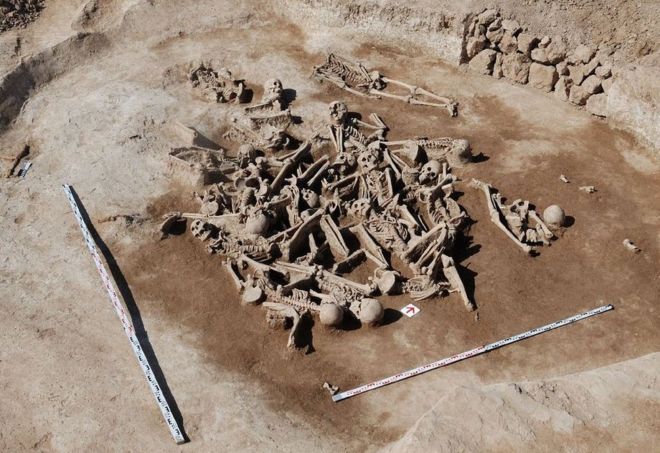 A mass burial of battle victims from the Xiongnu period in Mongolia. The Xiongnu warriors are linked to the nomadic people who would later become known as the Huns.Scientists say one of the deadliest plagues in history may be linked to the migration westward of the Hun peoples.The Justinian Plague, which struck in 541 AD, may have killed as many as 25 million.Now, scientists say the outbreak probably originated in Asia, not Egypt as contemporary and more recent chroniclers had thought.The finding comes from analysis of DNA found in 137 human skeletons unearthed on the Eurasian steppe.The steppe region covers a vast area, spanning some 8,000km from Hungary to north-eastern China. The large sample of individuals covers a date range of 2,500 BC - 1,500 AD.Writing in the journal Nature, Eske Willerslev, Peter de Barros Damgaard and others describe how they sequenced genomes from these individuals and, in two of them, recovered DNA from a strain of plague related to the one responsible for the Justinian Plague. A separate paper in the same edition of the journal describes the discovery of hepatitis B strains in ancient people from the Steppe.The plague pandemic is named after Justinian I, who ruled the Eastern Roman Empire (also known as the Byzantine Empire) at the time of the initial outbreak. Indeed, it is said that Justinian himself caught the disease, but recovered. A mass burial of battle victims from the Xiongnu period in Mongolia. The Xiongnu warriors are linked to the nomadic people who would later become known as the Huns.Scientists say one of the deadliest plagues in history may be linked to the migration westward of the Hun peoples.The Justinian Plague, which struck in 541 AD, may have killed as many as 25 million.Now, scientists say the outbreak probably originated in Asia, not Egypt as contemporary and more recent chroniclers had thought.The finding comes from analysis of DNA found in 137 human skeletons unearthed on the Eurasian steppe.The steppe region covers a vast area, spanning some 8,000km from Hungary to north-eastern China. The large sample of individuals covers a date range of 2,500 BC - 1,500 AD.Writing in the journal Nature, Eske Willerslev, Peter de Barros Damgaard and others describe how they sequenced genomes from these individuals and, in two of them, recovered DNA from a strain of plague related to the one responsible for the Justinian Plague. A separate paper in the same edition of the journal describes the discovery of hepatitis B strains in ancient people from the Steppe.The plague pandemic is named after Justinian I, who ruled the Eastern Roman Empire (also known as the Byzantine Empire) at the time of the initial outbreak. Indeed, it is said that Justinian himself caught the disease, but recovered. The city of Istanbul is the present-day incarnation of Constantinople, which was devastated by the Justinian Plague.The outbreak in Constantinople (which is now Istanbul in Turkey) was thought to have been carried to the city by rats on grain ships arriving from Egypt. While the plague was present in north-east Africa, the new research makes an origin in Central and Eastern Asia more likely.The researchers say the plague probably moved westward with the migration of tribes who would become known to Roman chroniclers as the Huns.Nomadic allianceThe Huns were not one people but formed from diverse nomadic groups such as the Scythians and the Xiongnu who forged allegiances to extend their power and territory. The Scythians were known to the Romans and Greeks as proficient horsemen living on the border between Europe and Asia. The Xiongnu are first attested further east, and fought a bloody war with the forces of Han dynasty China."In some of these Huns, we find the basic form of the Justinian Plague... that killed off millions of people in Europe," said co-author Eske Willerslev, from the University of Copenhagen.DNA from a strain of the plague bacterium (Yersinia pestis) closely related to the one involved in the Justinian pandemic was found in a Hun individual from the Tian Shan mountains of Central Asia who died around 200 AD. This Tian Shan strain is also more "basal" than the Justinian form of the plague, meaning it is further back in the plague's genetic "family tree". The city of Istanbul is the present-day incarnation of Constantinople, which was devastated by the Justinian Plague.The outbreak in Constantinople (which is now Istanbul in Turkey) was thought to have been carried to the city by rats on grain ships arriving from Egypt. While the plague was present in north-east Africa, the new research makes an origin in Central and Eastern Asia more likely.The researchers say the plague probably moved westward with the migration of tribes who would become known to Roman chroniclers as the Huns.Nomadic allianceThe Huns were not one people but formed from diverse nomadic groups such as the Scythians and the Xiongnu who forged allegiances to extend their power and territory. The Scythians were known to the Romans and Greeks as proficient horsemen living on the border between Europe and Asia. The Xiongnu are first attested further east, and fought a bloody war with the forces of Han dynasty China."In some of these Huns, we find the basic form of the Justinian Plague... that killed off millions of people in Europe," said co-author Eske Willerslev, from the University of Copenhagen.DNA from a strain of the plague bacterium (Yersinia pestis) closely related to the one involved in the Justinian pandemic was found in a Hun individual from the Tian Shan mountains of Central Asia who died around 200 AD. This Tian Shan strain is also more "basal" than the Justinian form of the plague, meaning it is further back in the plague's genetic "family tree".
 Justinian is said to have contracted the plague, but recovered from it.A relative of the Justinian Plague strain also turned up in an individual from North Ossetia, Russia, whose age is more uncertain, but who probably died between the sixth and ninth centuries AD.The Huns probably began their westward movement in the second or third century BC, appearing on the borders of the Roman Empire in the fourth century. They established a short-lived dominion in Europe through the displacement of existing tribal groups and with attacks on the Empire itself.Their ferocity was embodied by Attila, the Hunnic leader who fought numerous military campaigns against Rome.Horses for watercoursesCo-author of the study Peter de Barros Damgaard told BBC News: "Our strain dates back to [around] 200 AD, so several hundreds of years before the Justinian plague wreaked Europe."An appearance has also been found in Egypt. As such, increased interaction under the Hunnic and later the Turk Khaganate would have aided in bringing this plague strain through the Silk Road."Intensified trade is a very likely factor."DNA analysis of this plague strain shows it possessed mutations that would have allowed its transmission via fleas, much like the later Black Death. But whether this was the principal mode of spread in the sixth century outbreak remains unknown.Dr Damgaard said: "An interesting speculation is that Xiongnu warriors are documented through ancient Chinese historical sources to have used biological warfare by putting dead horse bodies in water sources."I like to speculate that this would have been the breeding ground for plague, and once again the human trajectory would have been linked to horses, but I have no way of proving that."Another paper in Nature, also led by Eske Willerslev, reports the oldest evidence of hepatitis B viruses (HBV) in humans. The findings come from viral sequences recovered from 12 ancient people on the steppe.Barbara Mühlemann, a co-author from the University of Cambridge, UK, said: "People have tried to unravel the history of HBV for decades - this study transforms our understanding of the virus and proves it affected people as far back as the Bronze Age."We have also shown that it is possible to recover viral sequences from samples of this age which will have much wider scientific implications."In 2015, some 257 million people were estimated to be infected with HBV; some 887,000 died due to complications such as liver cancer. Justinian is said to have contracted the plague, but recovered from it.A relative of the Justinian Plague strain also turned up in an individual from North Ossetia, Russia, whose age is more uncertain, but who probably died between the sixth and ninth centuries AD.The Huns probably began their westward movement in the second or third century BC, appearing on the borders of the Roman Empire in the fourth century. They established a short-lived dominion in Europe through the displacement of existing tribal groups and with attacks on the Empire itself.Their ferocity was embodied by Attila, the Hunnic leader who fought numerous military campaigns against Rome.Horses for watercoursesCo-author of the study Peter de Barros Damgaard told BBC News: "Our strain dates back to [around] 200 AD, so several hundreds of years before the Justinian plague wreaked Europe."An appearance has also been found in Egypt. As such, increased interaction under the Hunnic and later the Turk Khaganate would have aided in bringing this plague strain through the Silk Road."Intensified trade is a very likely factor."DNA analysis of this plague strain shows it possessed mutations that would have allowed its transmission via fleas, much like the later Black Death. But whether this was the principal mode of spread in the sixth century outbreak remains unknown.Dr Damgaard said: "An interesting speculation is that Xiongnu warriors are documented through ancient Chinese historical sources to have used biological warfare by putting dead horse bodies in water sources."I like to speculate that this would have been the breeding ground for plague, and once again the human trajectory would have been linked to horses, but I have no way of proving that."Another paper in Nature, also led by Eske Willerslev, reports the oldest evidence of hepatitis B viruses (HBV) in humans. The findings come from viral sequences recovered from 12 ancient people on the steppe.Barbara Mühlemann, a co-author from the University of Cambridge, UK, said: "People have tried to unravel the history of HBV for decades - this study transforms our understanding of the virus and proves it affected people as far back as the Bronze Age."We have also shown that it is possible to recover viral sequences from samples of this age which will have much wider scientific implications."In 2015, some 257 million people were estimated to be infected with HBV; some 887,000 died due to complications such as liver cancer.
|
|
Deleted
Deleted Member
Posts: 0
|
Post by Deleted on May 25, 2018 12:09:33 GMT -5
Joseph P Yap (translator), Wars With The Xiongnu: A Translation From Zizhi Tongjian, AuthorHouse, 2009. Description: Description:
This volume of - Wars with the Xiongnu is about a nomadic confederation - the Kingdom of Xiongnu to the north of ancient China, most notably for the relentless, atrocious and bloodletting wars that lasted for over two centuries with the mighty Han dynasty, comparable in size and power as Rome during its height. The roaming Xiongnu people, so powerful boasted of having a kingdom striding from Eastern Siberia to the west at the Altai Mountains in Central Asia, with territories so vast - even larger than the mighty Han at its zenith, were a wrath to its immediate neighbours for a period of no less than six centuries; yet with an estimated population of only one and a half million they were able to hold the Han Kingdom, during its height of fifty million people at bay. The powerful nomadic Kingdom rose to power from the midst of nowhere, reached its zenith, ran its course, its vitality and vigour spent, declined and vanished into oblivion without so much as a trace in the mists of time, albeit burial remains and textual references, predominantly from Chinese textual sources.
|
|
Deleted
Deleted Member
Posts: 0
|
Post by Deleted on Jun 6, 2018 16:38:13 GMT -5
The Artwork of Badam Otgontuvden of Mongolia. Sky  WITHING TAICHUD'S  ON THE EDGE OF LIFE AND DEATH
|
|
Deleted
Deleted Member
Posts: 0
|
Post by Deleted on Jun 6, 2018 16:43:53 GMT -5
Some more art from Badam Otgontuvden.  BURTE CHINU GUA MARAL. (Mythical ancestor of the Mongols)  Hunt.  HUAGCHIN MOTHER |
|
Deleted
Deleted Member
Posts: 0
|
Post by Deleted on Jun 6, 2018 16:48:01 GMT -5
...and some more art from Badam Otgontuvden  Last will (of Jamukha?)  Confession of Jamukha.  Queens |
|
Deleted
Deleted Member
Posts: 0
|
Post by Deleted on Jun 6, 2018 16:57:44 GMT -5
 BEGINNING WITHOUT END ( the young Temüjin and Qasar kill half-brother Bekhter)  Childhood.  |
|
|
|
Post by kemp on Jun 7, 2018 8:54:25 GMT -5
Hun, thanks for show casing some of Badam Otgontuvden's work.  |
|
Deleted
Deleted Member
Posts: 0
|
Post by Deleted on Jun 7, 2018 16:19:40 GMT -5
A new Mongolian Movie.  Legend of Gobi trailer. Legend of Gobi trailer.Here's a brief description: Film features the story of a fierce imposter Igler, who seized the power, violating the tradition of hereditary monarchy of horse headed fiddlers. More than 500 artists of UBS TV channel worked on the creation of the film for two years.
Main roles were portrayed by People’s Actor of Tyva Ondar Eduard Borisovich, O.Amgalanbaatar, People’s Actor P.Tserendagva, Ch.Ochgerel and B.Zamilan. Film score was composed by State Honored Cultural Figure B.Balkhjav and one of the soundtracks ‘Zurkhnii amrag’ was performed by the young actress, student of the MSUAC B.Zamilan.
Director Ts.Davaajargal and writer S.Sumiya said “We tried to show the importance and meaning of music and melody in human life through the film language, myths and legends. We also worked hard to show the beauty of the Gobi, not only the deserts and sand. Most beautiful scene of the film is the dream scene, which was shot in Teshil soum of Bulgan aimag”.
‘The legend of Gobi’ will take you to the mythical world of Gobi land for couple of hours.
B.Misheel |
|
Deleted
Deleted Member
Posts: 0
|
Post by Deleted on Jun 7, 2018 16:27:02 GMT -5
Here's a couple of songs from the movie.
Goviin domog by B.Zamilan
Lyrics in Mongolian.
Züüden kheetei orchlongiin
Züüsgel goyol shig setgel mini
Zümber tseejind siilbertei
Zürkhnii amrag aa
Saran denlüütei tengeriin door
Sanaj khüleene ee
Sanchig buural khorvoog
Khamtdaa tuulakhsan
Dakhilt:
Khan khurmast tenger mini
Khatuu bükhnii zööllöösei
Khanan gertee
Khanisakh zol ni ünen baig
Khan galuu khotolson
Khuvi tavilangiin toiromtoi
Khulan takhiin shünshigtei
Khutagtyn nutag mini
Naran urgakh talynkhaa
Mankhan dundaa
Nasny amrag chamaigaa
Khüleej suuna daa
Dakhilt:
Khan khurmast tenger mini
Khatuu bükhnii zööllöösei
Khanan gertee
Khanisakh zol ni ünen baig
Zambuuliin khorvoodoo
Zalbiral manasan ijii mini
Zayaa buyang mini
Tsatslaa örgön ariusgaarai
Bodol Khüsel by Ochgerel.
|
|
Deleted
Deleted Member
Posts: 0
|
Post by Deleted on Jun 12, 2018 17:32:01 GMT -5
Here's the episode from dailymotion: Epic Warrior Women: The Amazons This episode follows the life of fictional Scythian warrior Alkaya (Gaziza Tleubay, Amazon warrior on the left in the pic above) during the sixth century B.C. Narrated by Linda Carter. Languages: English and Kazakh (with subtitles). |
|
Deleted
Deleted Member
Posts: 0
|
Post by Deleted on Jun 24, 2018 2:05:36 GMT -5
Meet a lifelike 1700 year old Hun warrior with his bow and ‘whistling arrows’Words by Siberian Times Link: siberiantimes.com/science/others/features/meet-a-lifelike-2000-year-old-hun-warrior-with-his-bow-and-whistling-arrows/Mummified archer turns up in remote museum after locals refused to hand him over to the Hermitage in St Petersburg.
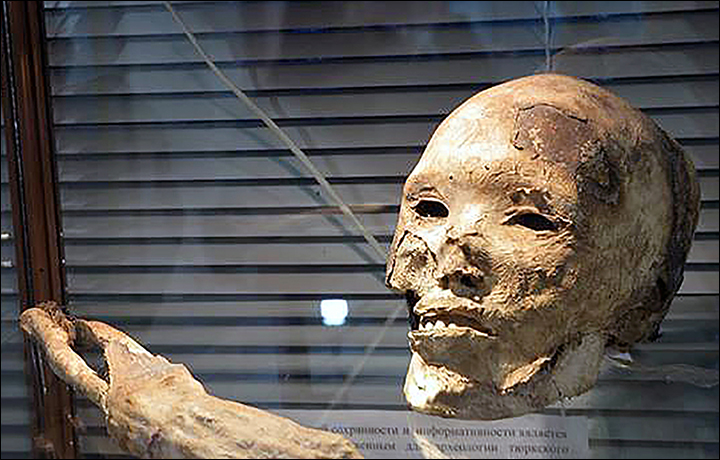 'Keep this head, do not give it to anybody, and one day your museum will be famous'. Picture: Kokorya Museum.The ancient warrior was buried in fur and lay on a wooden ‘bed’ in his burial chamber at a remote Altai Mountains site near the modern day village of Kokorya, some 314 kilometres south of regional capital Gorno-Altaisk. Next to the warrior was placed his weaponry. 'Keep this head, do not give it to anybody, and one day your museum will be famous'. Picture: Kokorya Museum.The ancient warrior was buried in fur and lay on a wooden ‘bed’ in his burial chamber at a remote Altai Mountains site near the modern day village of Kokorya, some 314 kilometres south of regional capital Gorno-Altaisk. Next to the warrior was placed his weaponry.
His bow in its heyday was some two metres in length; alongside its remnants were half a dozen well-preserved arrow shafts made of birch.
They were painted in black and white - so he knew which one to pull from the fur-lined quiver for each prey.
The arrows originally had iron tips.
 Eminent scientist Boris Kadikov from the Hermitage arrived too; he and a local researcher spent three days with the find. Picture: Kokorya Museum. Eminent scientist Boris Kadikov from the Hermitage arrived too; he and a local researcher spent three days with the find. Picture: Kokorya Museum.
A hollow whistle made of bull horn fixed on the arrow shaft, which also had an iron quiver hook. The whistling was produced not from the tip but the horn-made coupling between the tip and the shaft, say experts. The fearsome noise was supposedly used by warriors to scare the enemy.
Hun hunters deployed these weapons to confuse their prey forcing them into the open, when they could be shot with other arrows.
Deer would stop when they heard the whistling, making them easy targets.
|
|
Deleted
Deleted Member
Posts: 0
|
Post by Deleted on Jun 24, 2018 2:12:42 GMT -5
Meet a lifelike 1700 year old Hun warrior with his bow and ‘whistling arrows’, Part 2.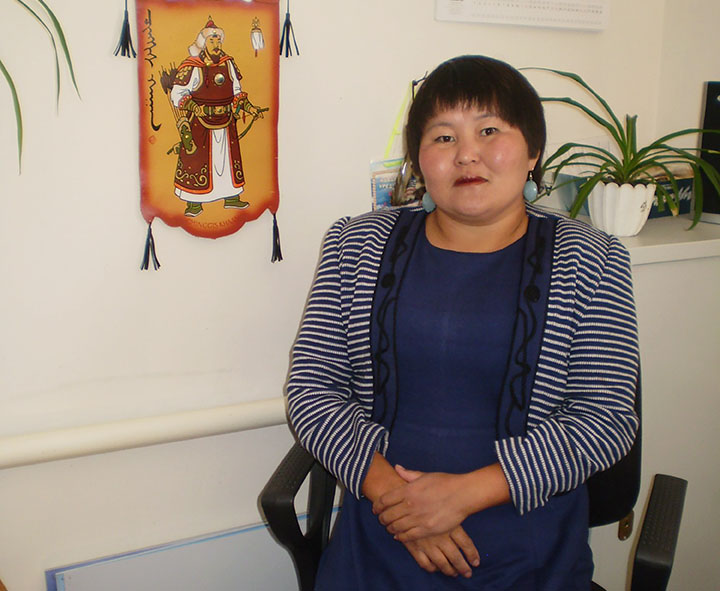 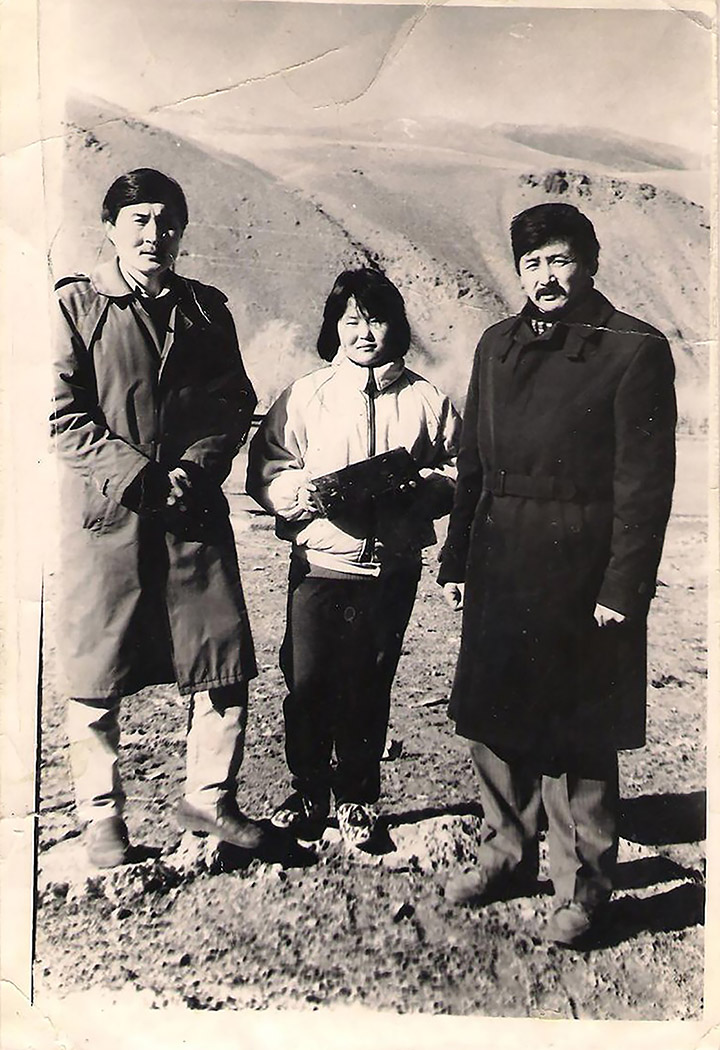 Alena Kypchakova, the museum keeper. Alena, in the middle, pictured as a child. Pictures: Alena Kypchakova. Alena Kypchakova, the museum keeper. Alena, in the middle, pictured as a child. Pictures: Alena Kypchakova.
![]() Squirrels jumped lower in their branches becoming more exposed, or leapt between trees - so going into the open. Squirrels jumped lower in their branches becoming more exposed, or leapt between trees - so going into the open.
Archeologist Dr Alexander Ebel, from Gorno-Altaisk State University, conducted an experiment to make a copy of the arrow whistle.
It didn’t work.
Yet a study by Novosibirsk archeologist Yury Khudyakov suggests these arrows did whistle, a phenomenon described in ancient Chinese literature.  The Hun warrior mummy, his bow and arrows. Pictures: Kokorya Museum. The Hun warrior mummy, his bow and arrows. Pictures: Kokorya Museum.
|
|
Deleted
Deleted Member
Posts: 0
|
Post by Deleted on Jun 24, 2018 2:16:26 GMT -5
Meet a lifelike 1700 year old Hun warrior with his bow and ‘whistling arrows’, Part 3.The mummified warrior was unearthed in 1993 at the remote at Kam-Tytugem settlement.
Alena Kypchakova, then 12, stumbled across the remains when she was set to work haymaking.
She has since taken over from her father running the local museum in Kokorya.
‘I saw a pile of stones,’ she recalled. ’It turned out that the grotto had collapsed. I found a hole between the stones, a way to get inside - and there was a grave.
‘I don’t remember it too well, but I know I was not scared.'
  Hello from 2,000 years ago. Pictures: Kokorya Museum.A local historian came and inspected the find. Hello from 2,000 years ago. Pictures: Kokorya Museum.A local historian came and inspected the find.
Before long eminent scientist Boris Kadikov from the Hermitage arrived too; he and a researcher spent three days with the find.
Attempts to persuade her father to surrender the find to faraway museums - notably the Hermitage - all failed.
'I remember Boris Kadikov told my father: 'Keep this head, do not give it to anybody, and one day your museum will be famous.’
This moment has come. 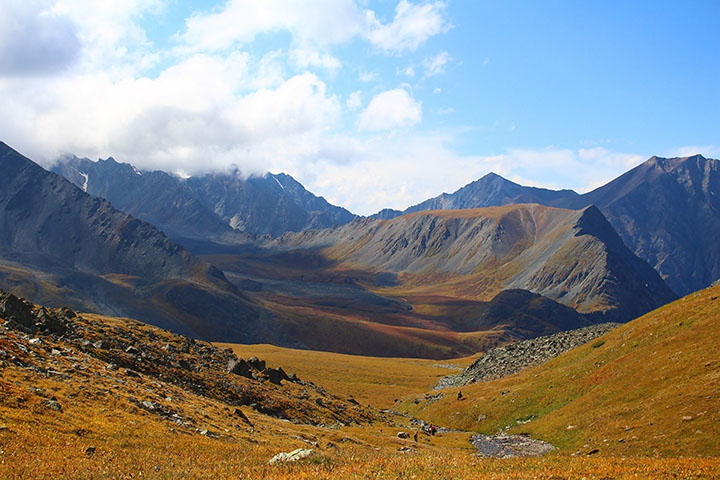 The area where the mummified head was found. Picture: Sailuyugem Nature Park. The area where the mummified head was found. Picture: Sailuyugem Nature Park.
|
|
Deleted
Deleted Member
Posts: 0
|
Post by Deleted on Jun 27, 2018 13:45:28 GMT -5
A Docudrama based on the life of Ulugh Beg, grandson of the great conqueror Timür: Ulugh Beg: The Man Who Unlocked the Universe -- Documentary TrailerThe documentary tells the story of one of the greatest scientists, astronomer, mathematician, the last thinker of Eastern Renaissance Mirzo Ulugh Beg. He was the grandson of the conqueror Tamerlan, the ruler of Timurid Empire.
Two hundred years before Galileo Galilei, in pre-telescope times, Mirzo Ulugh Beg created the most precise star catalog in the world! He also built the biggest observatory at that time in the capital of his empire Samarkand. His achievements far exceeded the world he lived in, he is a true prodigy.
Mirzo Ulugh Beg was born in the epoche of religious rebellions and instability, and he dedicated his life to science! The award he got in return was the brutal execution ordered by his older son!
Link: www.ulughbegmovie.com |
|


































